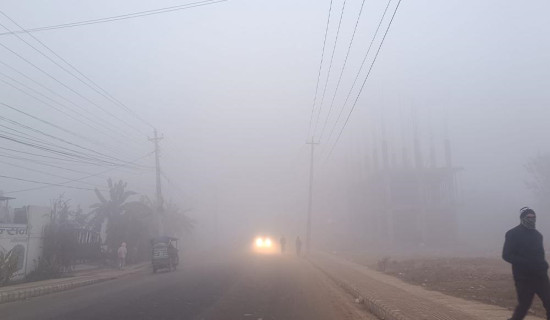- Sunday, 28 December 2025
Promote Insurance Business In Nepal
The insurance sector is part of the financial system. Like the banking sector and the stock market, the insurance sector also plays a pivotal role in promoting and boosting the financial sector. The insurance sector is considered one of the important players in financial intermediation as it contributes to economic development and growth as well as to financial mobility and activity. The importance of the insurance sector is growing in both developed and developing countries. The insurance sector plays a crucial role in international capital markets.
The insurance sector is similar to banks and capital markets. The insurance sector is often linked to macroeconomic factors. The role played by this sector in national as well as international trade can hardly be overstated. It is due to the provision of insurance that business entrepreneurs are ready to take risks, even aggravated ones, while carrying on business internally or externally. The insurance sector meets the needs for protection of goods and properties of not only businessmen but also the general public. Organisations like banks, companies and other entities buy insurance policies for their property and staff. The government has made it mandatory for vehicle owners to insure their vehicles. However, owners of two-wheelers usually buy third-party insurance policies.
Global norms
Insurance is basically of two types: life insurance and non-life insurance. Life insurance, also called life assurance, includes various products of insurance such as life policies, endowment policies, money-back plans and children’s insurance plans and pension plans. In like manner, non-life insurance covers health, home, fire, riots, burglary, earthquake, group accident, travel, aviation, marine and miscellaneous policies. In Nepal, insurance companies are operating under the Insurance Act, 1992. They are under the supervision of the Beema Samiti. They follow internationally accepted norms relating to insurance business.
In 1937, the Nepal Bank Limited (NBL) was established as the first bank of Nepal. At the time, there was no Nepali insurance company operating in the country. However, there were Indian insurance companies doing business. These companies were taking money earned in the country to India. To end the monopoly of the Indian insurance companies, the Nepal Insurance and Transport Company was established in 1947 under the ownership of the NBL. The scenario changed a bit after the introduction of democracy in 1951. Investments in education, transport, trade and other sectors gradually increased. Still, the Indian insurance companies held sway over the insurance market as the Nepali insurance company had limited resources and was in the incipient phase.
However, the demand for insurance services was growing. So the government established the Rastriya Beema Sansthan Private Limited, which was converted to the Rastriya Beema Sanstahan in 1968. In the same year, the Beema Samiti was also set up. Its main objectives were to systematise, develop, supervise and regulate the insurance sector. In the same year, the General Insurance Company was established as a private company. In 1974, the General Deposit Insurance and Credit Guarantee Company was set up to ensure the security of deposits and credit.
After the re-introduction of multi-party democracy in the 1990s, a sea change took place in the financial sector as well as in other sectors under the economic liberalisation and open market policies adopted by the government. And the insurance sector also witnessed a burgeoning number of insurance companies. As of Asadh-end, 2080, there were 14 life insurance companies, 14 non-life insurance companies, two re-insurance companies and four micro-insurance companies. The number of branch offices of all the insurance companies stood at 2,801. Those directly employed in the insurance industry were 11,496. Insurance agents numbered 277,626, and surveyors 1,217.
As per the Nepal Insurance Authority, during the fiscal year 2079/80, the insurance premium amounted to Rs. 182.91 billion, which represented a growth of 2.8 per cent over the fiscal year 2078/79 (Rs. 177.81 billion). The insurance cover was 39.09 per cent, or 44.38 per cent if foreign employment term life insurance policies were also accounted for. In the fiscal year 2078/79, the insurance cover stood at 41.39 per cent, accounting for including foreign employment term life insurance policies. Likewise, the gross premium of the insurance companies constituted 3.4 per cent of the gross domestic product in the fiscal year 2079/80, which was lower than in the fiscal year 2078/79 (3.6 per cent).
Premiums
The main income of the insurance industry is premiums. The insurance companies use funds from premiums, reserves and capital to pay claims and to bear administrative and other expenses. The remaining funds are invested in such sectors as directed by the Insurance Board. The insurance companies mobilise huge funds from premiums every year. These funds can be invested in development projects and in other productive sectors. In a cash-strapped county like ours, such funds provide relief for the initiation of projects designed for overall national development. However, the insurance sector does not seem to be receiving as much attention as required. The government has paid attention to the promotion of the banking sector and the stock market. But the insurance sector seems neglected.
The insurance market is limited. However, there is much potential for the market to grow. There is a negative perception that it is difficult to receive claimed amounts from the insurance companies. There is some truth in it. The insurance companies should also reform their procedures for honouring claims and settle claims at the earliest. At the same time, the government and other stakeholders should incentivise the insurance sector as an important component of the financial sector.
(Maharjan has been regularly writing on contemporary issues for this daily since 2000.)
















